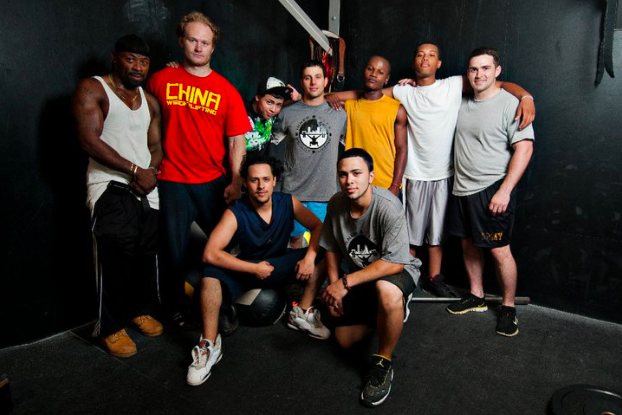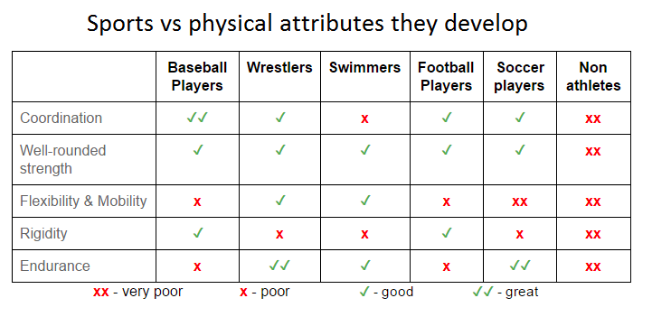What sports give us the biggest advantage for weightlifting?
From 2010 to 2011 I was the coach of Innercity Weightlifting (ICW) in Boston. Our group’s mission was to help at-risk youth get away from gangs, DYS centers, and bad domestic situations. Our tool was weightlifting. We taught the snatch, clean & jerk, squats, and presses. The goal was to give these kids the strength, confidence, and discipline to walk away from all types of bad situations (or at the very least, wear them out so they’d be too damn tired to go out with their friends after training).
Some kids learned quickly, others struggled with technique. Some increased their strength steadily, while others barely improved. Their rate of improvement seemed random at first, until I started asking what sports they played before starting weightlifting.
There is always carryover from past athletic experiences to how fast people are able to pick up a new sport. The attributes that kids gain from whatever sports they play stay with them forever – body-position awareness, speed, strength, work ethic, etc.
For this post, I wanted to explore which sports give people (especially young athletes) a competitive advantage in weightlifting.
***
Weightlifting is demanding. To be successful in weightlifting, an athlete must have strength, speed, coordination, and endurance.
At Innercity Weightlifting, we worked mostly with track athletes, baseball, basketball, soccer or football players, wrestlers, and kids who’ve never really played any sports.
The following chart shows the observations I made of the pros and cons kids had coming from different athletic backgrounds into weightlifting:
The ones who learned technique and gained strength the quickest were the baseball players and wrestlers.
Baseball players
1) Great coordination – allowed them to pick up technique quickly.
2) Well-rounded strength – allowed them to have good control over the bar.
3) Good rigidity – allowed them to stand strong in every position.
4) Endurance was lacking – because of which they couldn’t work hard for more than an hour.
5) Flexibility wasn’t great – because of which they couldn’t get into correct weightlifting positions.
Wrestlers
1) Good coordination – allowed them to pick up technique quickly
2) Well-rounded strength – allowed them to have good control over the bar
3) Flexibility and mobility – allowed them to get into every correct weightlifting position.
4) Great endurance – allowed them to train intensely for 2+ hours per session.
5) Poor rigidity – because of which they were unable to stop themselves and the bar quickly.
***
Most weightlifting coaches recommend that kids start weightlifting when they are 11-13 years old (exposure to weightlifting, not specificity). However, coaches do want to recruit kids who already have the physical and mental abilities required for weightlifting. I had the chance to ask several professional weightlifting coaches what sports they recommend kids do before going into weightlifting. Here’s what they said:
Boris Sheiko – Honored coach of Kazakhstan in Weightlifting. Honored coach of Russia in Powerlifting.
1. Ball games (any) – to develop coordination and quickness.
2. Swimming – as it develops well-rounded strength throughout the body without impact.
Arnold Khalfin – Soviet Union Weightlifting Champion. Professional weightlifting coach, with over 50 years of coaching experience and who has developed hundreds of ‘Masters of Sport.’
1. CrossFit – develops well-rounded athletes (as long as strength is not emphasized, and proper technique is used in everything).
2. Volleyball – builds speed, coordination, and endurance (volleyball players are the highest jumpers (power) which is very beneficial for weightlifting).
Vladimir Safonov – Professional weightlifting coach. Developed Olympic medalists and World Champions.
1. Wrestling – develops coordination, speed, strength, endurance, and mobility.
2. Gymnastics – develops coordination, speed, strength, endurance, and mobility.
Sean Waxman, Professional weightlifting coach. Developed National Champions and world team members. Head coach of Waxman’s Gym.
1. Gymnastics – develops muscular endurance, mobility, power, a good strength-to-body-weight ratio, and kinesthetic awareness (ability to sense where the body is positioned).
2. Diving – develops mobility, power, a good strength-to-body-weight ratio, and kinesthetic awareness.
Kevin Doherty, Professional weightlifting coach. Developed National Champions and world team members. Head coach of Hassle Free Barbell.
1. Track and field – develops explosive and directional power.
2. Football – develops explosive and directional power.
5 coaches, 5 differing opinions. Some sports are better at developing the specific characteristics required for weightlifting, but every sport has something to offer.
***
All of this applies to pre-weightlifters. So, how does this apply to you, the seasoned weightlifter?
Well, to become better at weightlifting, the snatch and clean & jerk are not enough. When an athlete starts weightlifting, they shouldn’t stop other physical activities all together.
In the Soviet Weightlifting System, young weightlifters devote up to 80% of their time to General Physical Preparation, playing ball games, running, jumping, and doing gymnastics. As they progress, even though they reduce the focus on general physical preparation, it still remains an important part of their training (you can read much more on that in Roadmap for Training, Part 2).
These same principles apply to adult weightlifters.
All weightlifters should use powerlifting (such as squats, pulls, presses) to get stronger, and light athletics (such as running and jumping) to get faster and more explosive.
Ilya Ilyin swims for active recovery, which helps him with mobility and endurance without adding major stresses to his body. Vasily Polovnikov runs and plays soccer for endurance and speed. I try a new physical activity or sport once a week to build coordination, speed, and to distract myself from the daily grind of training.
Playing other sports to supplement general athletic development can make you a better lifter.
What sport did you play growing up, and what advantage did it give you?
Editors note: This article is an op-ed. The views expressed herein are the authors and don’t necessarily reflect the views of BarBend. Claims, assertions, opinions, and quotes have been sourced exclusively by the author.

